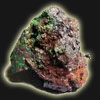
The name Cuprite comes from the Latin cuprum, meaning copper. This stone teaches humanitarian principles and how to help others. It assists in exploring past lives and learning from experiences the soul has undergone. Cuprite helps us to overcome difficulties with father, guru, teacher or other authoritarian figures, present or past, releasing rigid control.
Strengthening the will and assisting in talking responsibility for one’s own life, Cuprite attracts a mentor where required. A powerful energy conduit, this stone gives great vitality and strength, providing support if there is fear of a terminal condition or when you are determined to overcome a potentially fatal illness.
Cuprite, soft, heavy, red oxide mineral (Cu2O) is an important ore of copper. A secondary mineral often formed by the weathering of copper sulfide minerals, cuprite is widespread as brilliant crystals, grains, or earthy masses in the oxidized zone of copper lodes. Cuprite has been a major ore of copper and is still mined in many places around the world. Of all the copper ores except for native copper, cuprite gives the greatest yield of copper per molecule since there is only one oxygen atom to every two copper atoms.

Sign of Cuprite: Aquarius
As a mineral specimen, cuprite shows fine examples of well-developed cubic crystal forms. Cuprite's dark crystals show internal reflections of the true deep red inside the almost black crystal. Other varieties, such as chalcotrichite, show tufts of needle-like crystals that have a beautiful red color and a special sparkle that make them popular display cabinet specimens.
Cuprite is most commonly used for ornamental carvings, or in bead form. If used for jewelry purposes, Cuprite is almost exclusively fashioned into cabochons. Cuprite should only ever be cleaned with a soft, dry cloth. Avoid exposure to chemicals, prolonged sunlight, or extremes of temperature change, as this can cause permanent coloration changes. Both ultrasonic and steam cleaners are to be avoided. Store your Cuprite jewelry away from harder jewelry that may scratch or damage this softer stone.
Rejuvenation, vitality, libido, sexual function, metabolic imbalances, heart, blood, muscle tissue, skeletal system, AIDS, cancer, blood disorders, water retension, bladder and kidney malfunction, vertigo, altitude sickness. Helpful to smokers and to lungs in a polluted atmosphere.
It attracts what you need to survive and helps the body take in vital life force. Through the blood, life force passes to the cells of the body, which it invigorates and rejuvenates, restoring normal functioning. Cuprite eases the mind with regard to worries and situations over which one has no control.
Tennessee, Arizona, USA, Bolivia, Mexico, Japan, Australia, Germany, Africa, Chile and several localities in Europe.
